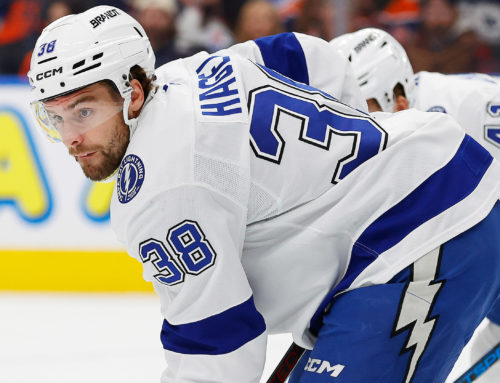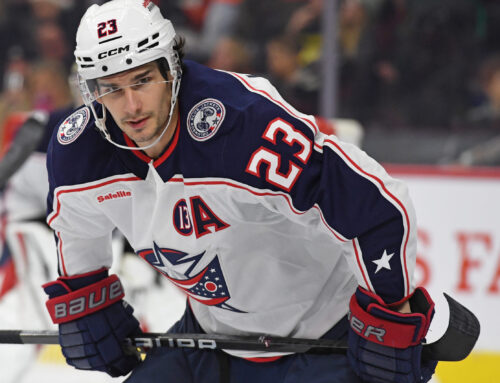The week we are headed for the third of four playoff series articles. Now that the second round is wrapped let's dig into our newest eliminated teams. As a quick reminder, the teams that went down in the second round were Edmonton, New Jersey, Toronto, and Seattle. Like the last two articles we are going to take a look at these four teams and focus on deployment. The rationale and process is the same as the prior articles, but as a reminder here is a little chunk from the original.
It is such a small sample size that we are not going to read too much into point paces, shot rates, etc. but instead look at how players were utilized in these win-or-go-home series. Doing so might give us a bit of insight into how coaches are viewing certain players and who might be primed for a different role next season compared to this one. This is also the playoffs so to some extent we would assume that a team's top players see a bit of an increase while some depth players might fall off a bit.
And now on to the process. We will be looking at deployment and specifically percent of time on the power-play, and total time on ice. We will be using percent when possible as overtime games can add significant time to a player's overall count without changing that player's real deployment opportunity. In order to get this data, we will be running a Big Board report for the playoffs and comparing that to a second custom Big Board report for the last two months of the regular season. That comparison will tell us which players have gained or lost time between these two samples.
The following tables can be a little bit cumbersome, but essentially, we are looking at four data points. We have basic scoring data (points per game, and shots per game), then basic time on ice data (percent of the power-play, and total time on ice). The first white section of the table is player information. The gray section is the player's performance during the playoffs, and the final white section is the difference between playoff performance and the final two months of the regular season so we can see who lost and gained time.
First up in alphabetical order, Edmonton.
| Name | Pos | GP | PTS/ GP | SOG/ GP | %PP | TOI | Δ PTS/GP | Δ SOG/GP | Δ %PP | Δ TOI |
| CONNOR MCDAVID | C | 12 | 1.67 | 4.25 | 79.7 | 23:43 | -0.26 | -0.23 | 0.5 | 1:48 |
| LEON DRAISAITL | C | 12 | 1.5 | 3.75 | 78.9 | 23:08 | -0.22 | 0.61 | -1.5 | 1:49 |
| EVAN BOUCHARD | D | 12 | 1.42 | 2.42 | 79.5 | 23:00 | 0.66 | 0.62 | 10.6 | 3:12 |
| MATTIAS EKHOLM | D | 12 | 0.58 | 1.67 | 16.5 | 21:53 | 0.04 | -0.05 | -1.9 | 0:45 |
Edmonton has a somewhat odd combination of data points. Almost all players either maintained or lost percent time on the power-play. Mostly the changes were pretty small which tells me that the team maintained more or less the same deployment as during the regular season. The one exception seems to be Evan Bouchard. He was already seeing an increase after Tyson Barrie left town, but he jumped up again in the playoffs. This data just emphasizes the main takeaway from trade deadline day: Bouchard is a must watch. He is currently over a point per game in actual production (which may or may not continue), but his deployment has been excellent over these time periods.
| Name | Pos | GP | PTS/ GP | SOG/ GP | %PP | TOI | Δ PTS/GP | Δ SOG/GP | Δ %PP | Δ TOI |
| KLIM KOSTIN | L | 12 | 0.42 | 0.83 | 4.1 | 7:44 | 0.02 | 0.13 | 3.1 | -1:11 |
| KAILER YAMAMOTO | R | 12 | 0.33 | 1.00 | 1.8 | 14:42 | -0.15 | -1.11 | -9.1 | -1:44 |
| NICK BJUGSTAD | C | 12 | 0.25 | 1.33 | 3.1 | 13:34 | 0.01 | -0.55 | -18.8 | -1:16 |
| MATTIAS JANMARK | R | 5 | 0.2 | 0.60 | 0 | 8:26 | -0.18 | -0.43 | -2.7 | -5:09 |
As far as players who lost time, we see some drops in power-play deployment, but outside of Kailer Yamamoto these are players who usually don't get any. Yamamoto is now a season removed from his breakout fourth quarter in 2021-22 and nothing, the regular season data, or the playoff data seem to indicate an increase in confidence or performance for him at this point.
On to New Jersey:
| Name | Pos | GP | PTS/ GP | SOG/ GP | %PP | TOI | Δ PTS/GP | Δ SOG/GP | Δ %PP | Δ TOI |
| ONDREJ PALAT | L | 12 | 0.58 | 1.33 | 49 | 16:51 | 0.24 | -0.29 | 11.8 | 2:09 |
| ERIK HAULA | L | 12 | 0.5 | 1.92 | 37 | 17:35 | -0.21 | -0.40 | 10.9 | 1:12 |
| MICHAEL MCLEOD | C | 12 | 0.5 | 1.58 | 2.3 | 14:47 | 0.21 | 0.51 | 0.5 | 3:16 |
| DAMON SEVERSON | D | 12 | 0.25 | 1.00 | 40.7 | 18:33 | -0.25 | -0.30 | 10.6 | -1:35 |
| LUKE HUGHES | D | 3 | 0.67 | 1.33 | 37.4 | 19:15 | -0.33 | 0.33 | 34.3 | 3:01 |
Ondrej Palat's deployment certainly got a bit better, but the exciting name (though he only got three games) is Luke Hughes. Certainly less than 20 minutes isn't much for a defenseman during the playoffs, but seeing his total time, and his power-play percentage increase in these pivotal games is a vote of confidence.
| Name | Pos | GP | PTS/ GP | SOG/ GP | %PP | TOI | Δ PTS/GP | Δ SOG/GP | Δ %PP | Δ TOI |
| JACK HUGHES | C | 12 | 0.92 | 3.67 | 61.6 | 19:44 | -0.22 | -0.15 | -10.5 | 0:08 |
| TIMO MEIER | L | 11 | 0.36 | 3.36 | 50.8 | 16:52 | -0.24 | -0.20 | -17.6 | -2:15 |
| DOUGIE HAMILTON | D | 12 | 0.33 | 1.92 | 59.5 | 20:52 | -0.4 | -1.05 | -10.2 | 0:05 |
| MILES WOOD | L | 8 | 0.25 | 1.50 | 1.6 | 10:57 | -0.15 | -0.22 | -18.4 | 0:45 |
| YEGOR SHARANGOVICH | L | 3 | 0 | 0.67 | 0.3 | 10:57 | -0.35 | -1.20 | 0.1 | -3:38 |
Oddly a lot of big names saw reduced opportunity during the postseason. Jack Hughes, Timo Meier, and Dougie Hamilton all saw drops of power-play percentage despite still being on the team's top unit. There isn't too much to go into there as they will be top options going forward. The lingering question is Timo Meier. His point production has been cause for concern, but a lot of the underlying numbers for him still look good. His loss of power-play deployment isn't too alarming given the same is true for Hughes and Hamilton, but the loss of two minutes of overall time isn't great. There is a question as to whether or not Meier will be back in NJ, so given that and his underlying numbers I wouldn't be too concerned at this time.
And now Toronto:
| Name | Pos | GP | PTS/ GP | SOG/ GP | %PP | TOI | Δ PTS/GP | Δ SOG/GP | Δ %PP | Δ TOI |
| MITCHELL MARNER | R | 11 | 1.27 | 3.00 | 72.5 | 24:08 | -0.08 | 0.58 | -0.9 | 2:55 |
| RYAN O’REILLY | C | 11 | 0.82 | 1.91 | 59.8 | 19:49 | -0.05 | 0.18 | 27.4 | 3:03 |
| JOHN TAVARES | C | 11 | 0.73 | 4.00 | 73.8 | 18:44 | -0.31 | 0.65 | 5.7 | 1:04 |
| TJ BRODIE | D | 11 | 0.27 | 0.82 | 9.7 | 23:20 | 0.08 | 0.09 | 7.6 | 2:08 |
| LUKE SCHENN | D | 11 | 0.09 | 1.27 | 0.9 | 17:27 | -0.13 | 0.49 | 0.9 | 3:23 |
Much has already been made of the performance of the Core Four. Two of them (Mitch Marner, and John Tavares) saw decent bumps in ice time during the post season. There isn't much to do with this information, we already know they are mainstays. The interesting names are Ryan O'Reilly, and Luke Schenn. Each were brought on at the deadline for the playoff run. O'Reilly had a great end to the regular season, but struggled in anchoring his own line in the playoffs. He saw more time, but did not produce with it. Luke Schenn wasn't supposed to score (which is great as he didn't) but did see an increase of almost three and a half minutes per game. Both could have some value depending on landing locations.
| Name | Pos | GP | PTS/ GP | SOG/ GP | %PP | TOI | Δ PTS/GP | Δ SOG/GP | Δ %PP | Δ TOI |
| WILLIAM NYLANDER | R | 11 | 0.91 | 4.27 | 39.2 | 18:45 | -0.02 | 0.81 | -34.3 | 0:23 |
| MATTHEW KNIES | L | 7 | 0.57 | 1.00 | 14.2 | 13:07 | 0.24 | -0.33 | -17 | 0:00 |
| CALLE JARNKROK | L | 11 | 0.27 | 0.91 | 22.2 | 14:27 | -0.23 | -0.59 | -5.1 | -1:06 |
| SAM LAFFERTY | R | 9 | 0.33 | 0.89 | 5.7 | 10:41 | 0.01 | -0.55 | -16.6 | -3:41 |
| ZACH ASTON-REESE | L | 6 | 0.17 | 0.67 | 0 | 8:53 | -0.1 | -0.83 | -0.3 | -2:00 |
| TIMOTHY LILJEGREN | D | 5 | 0 | 0.40 | 4.6 | 15:16 | -0.21 | -0.93 | -12.5 | -2:20 |
William Nylander losing 34 percent of his power-play time is concerning, but otherwise nothing too surprising here. We have a number of bottom six players who lost time in the playoffs. For Nylander it is a little bit of a warning sign that his spot might not be as secure as we could hope, but I have a hard time seeing Nylander losing out long term on the top power-play to O'Reilly, or someone like him since O'Reilly may not be a Leaf by the start of next season.
And finally, Seattle:
| Name | Pos | GP | PTS/ GP | SOG/ GP | %PP | TOI | Δ PTS/GP | Δ SOG/GP | Δ %PP | Δ TOI |
| YANNI GOURDE | C | 14 | 0.93 | 1.79 | 11.8 | 19:38 | 0.4 | -0.08 | -13.9 | 2:12 |
| JORDAN EBERLE | R | 14 | 0.79 | 2.21 | 55.3 | 18:07 | -0.04 | 0.01 | 10.4 | 1:03 |
| JADEN SCHWARTZ | L | 14 | 0.71 | 2.93 | 53.2 | 18:15 | 0.1 | 0.25 | 9.2 | 0:58 |
| TYE KARTYE | L | 10 | 0.5 | 1.30 | 21.4 | 12:21 | 0.5 | 1.30 | 21.4 | 12:21 |
Nothing surprising going on here. The most experienced players on the team saw a bump in ice time. It is clear which players coaches lean on when big games are on the line. Tye Kartye is the exception. I was considering not including him as he has no regular-season game comparison, but the AHL Rookie of the Year made a splash with some big goals in Seattle and was getting close to 15 minutes of ice time overall by the end of the Dallas series. It will be interesting to see if there is a spot for him next season.
| Name | Pos | GP | PTS/ GP | SOG/ GP | %PP | TOI | Δ PTS/GP | Δ SOG/GP | Δ %PP | Δ TOI |
| OLIVER BJORKSTRAND | R | 14 | 0.57 | 2.57 | 42.6 | 17:34 | -0.02 | 0.33 | -9.5 | 1:42 |
| EELI TOLVANEN | L | 14 | 0.57 | 2.00 | 44 | 16:20 | 0.04 | 0.23 | -7.5 | 1:15 |
| VINCE DUNN | D | 14 | 0.5 | 1.93 | 44.1 | 23:10 | -0.36 | 0.03 | -12.3 | -0:01 |
| JARED MCCANN | R | 8 | 0.38 | 2.75 | 46.7 | 14:32 | -0.75 | -0.72 | -9.4 | -3:14 |
| CARSON SOUCY | D | 14 | 0.14 | 1.21 | 0.7 | 14:35 | -0.09 | -0.09 | -2 | -1:45 |
| RYAN DONATO | C | 14 | 0.14 | 1.71 | 1.9 | 9:05 | -0.09 | -0.05 | -1 | -1:21 |
Oliver Bjorkstrand and Eeli Tolvanen combined with Yanni Gourde to form a pretty dynamic line during this postseason. They all saw increases in total time on ice, but decreases on the power-play. They were an effective line at even strength, but for any one of them to be valuable going forward they need to start clicking on the power-play. Losing out on an average of 10 percent of the power-play time doesn't bode well. I am tempted to put an asterisk for Jared McCann as he missed time, and then had to return from injury, but he and Vince Dunn also disappeared somewhat. Both lost decent shares of power-play time, which is some indication of lingering growing pains and a potential note of caution after breakout seasons in 2022-23.
That is all for this week
Do your part to support organizations working to make hockey for everyone.





 CAR
CAR FLA
FLA TOR
TOR DAL
DAL MTL
MTL T.B
T.B S.J
S.J PHI
PHI
